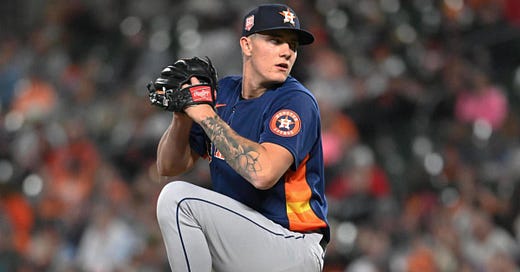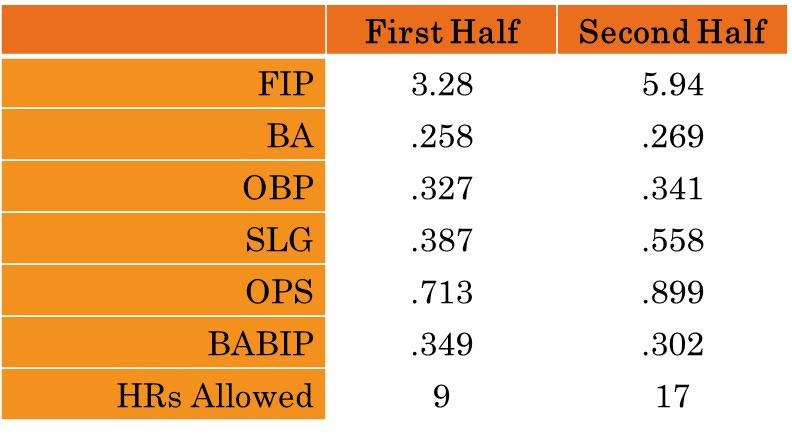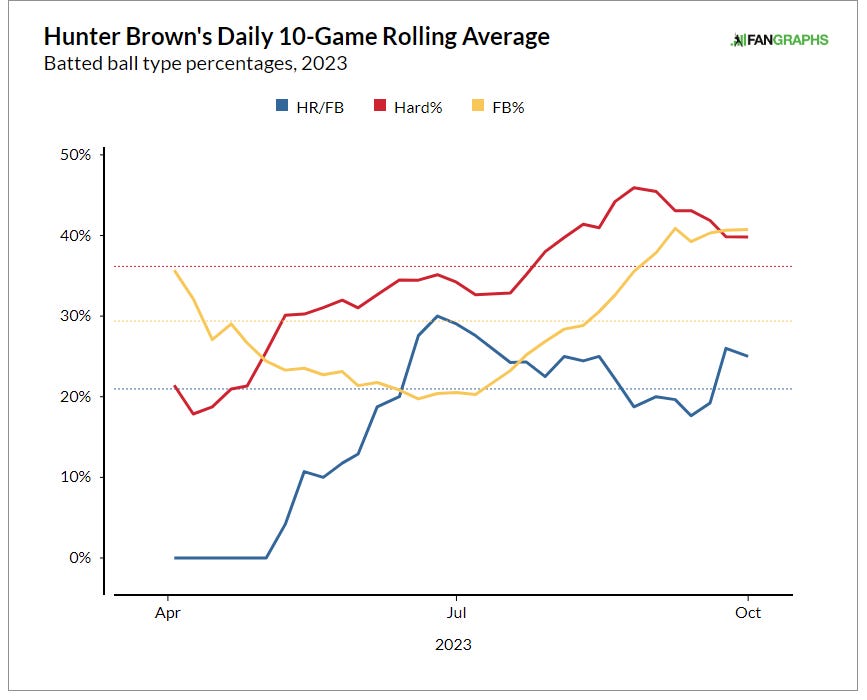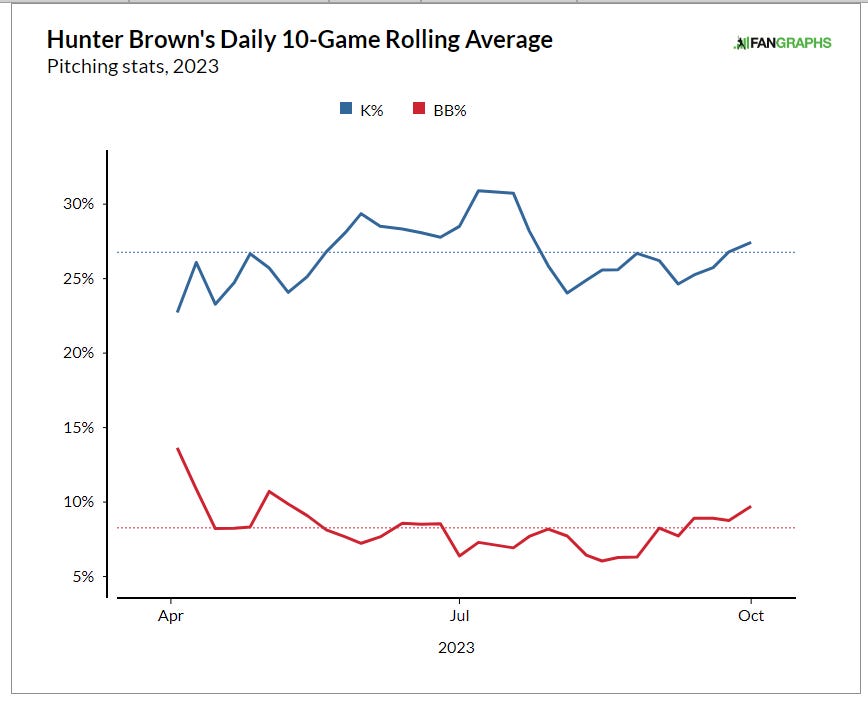Can Hunter Brown Cut Down on Homers Allowed? There Are Reasons to Think Yes
Hunter Brown's 2023 collapsed in the second half as he gave up a lot more hard contact. But his strikeout rates remained high. Projections indicate he will keep more balls in the yard this year.
In 2023, Hunter Brown had an ERA of 5.09. That’s obviously not good. But he had a FIP—which tries to remove the effects of batted ball luck—of 4.37. That’s a lot better. And his xERA—which is based on exit velocity and launch angle—was even lower at 4.27, and his xFIP was 3.52.
Those varying numbers raise the question of what we can expect from Hunter Brown in 2024. Projections expect him to be be somewhere between his xERA and his xFIP. For example, ATC projects that Brown will have a 4.00 ERA in 2024. That’s not ace level, but it useful mid-rotation starter. ATC projects Brown for 2.3 fWAR in 147.2 innings; that’s the 51st highest among all major league pitchers.
Projections think that Brown’s 2024 will not look like his 2023 did from a run production standpoint. Instead, they think his numbers will look more like what numbers like FIP, xERA, and xFIP think his numbers should have looked like last season.
A Second Half of Hard Hit Balls
So what went wrong in 2023 for Brown? One answer is that he declined over the course of the season, with some thought that Brown wore down over the largest workload of his career.
Brown’s own assessment of his 2023 decline discusses how fatigue led to issues with his mechanics.
“I think some things in my mechanics changed — probably due to fatigue — without even realizing it. I was getting a little bit more crossfire, which diminished my ability to get the fastball away to right-handed hitters especially and leaving it more arm-side. Righties, in particular, were able to do more damage on my harder fastball (and) cutter because I wasn’t getting it extension side due to those mechanics.
Whatever the cause of Brown’s decline, the results are clear. The chart below shows Brown’s numbers before and after the All Star Break. Brown was notably better in the first half of the season. His FIP was 3.28 (quite good), as compared to his awful 5.94 in the second half of the season.
Brown’s issue wasn’t giving up more hits or walks. His batting average and on base percentage allowed increased only slightly in the second half. Almost all of his decline came fron allowing more extra base hits. His slugging percentage allowed increased from .387 to .558, mostly because of a large increase in homers allowed. Brown gave up only 9 home runs in the first half. In the second half, Brown gave up 17, the 4th most of any major leaguer.
Another part of Brown’s issue was giving up an increasing share of fly balls as the 2023 season progresses. You can see the increase in fly balls in the second half, and how it goes up in parallel to Brown’s hard hit rate.
The combination of fly balls and hard hits are bad for a pitcher because they tend to go over the fence. Ground balls are of course better, because no matter how hard they are hit, they have the potential to be fielded.
Brown is a ground ball pitcher. In the first half of the season, his ground ball rate of 55.3% was seventh highest among starting pitchers. In the second half, Brown’s ground ball rate dipped to 48.3%.
Reasons for Optimism
Despite Brown’s regression in his hard hit and ground ball rates, there were areas where he remained steady in 2023—his ability to get strikeouts and to avoid walks. The chart below shows the 10-game rolling average of Brown’s strikeout and walk rate over 2023, and the bumps and wiggles are relatively small.
Over the course of the 2023 season, Brown struck out 26.8% of the batters he faced, 15th best among major leaguer starters. Brown’s walk rate was near league average at 8.3%.
Put those two together and Brown’s K%-BB% was 18.6%, which was the 23rd best in the majors. That’s quite good. Projections expect a small bit of regression from Brown in his strikeout rate to 25.5%, but a similar walk rate (8.8%), right about league average. Having above average strikeout rates and average walk rates is an effective formula to get outs, and that is what we can expect from Brown in 2024.
Fewer Homers?
The other thing that projections say we can expect from Brown in 2024—fewer homers. He gave up 27 in 2023. Projections say he will give up between 16 and 18 in 2024.
But it’s actually more important to look at the rate of homers. Projections indicate he will give up around 1.06 homers for every 9 innings in 2024, according to the ZIPS projections. That’s a big decrease from his 1.50 HR/9 rate in 2024, which was the 14th highest in the majors.
Why do projections think that Brown will give up home runs at a lesser rate. One answer is that Brown was able to avoid the home run ball before 2023. In 2022, Brown threw 130 innings between AAA, the majors, and the playoff innings, and allowed only 5 home runs. In 2021, he gave up 12 in 100.1 innings split between Corpus Christi and Sugar Land.
The other reason is that some degree of home runs are luck. In 2023, Brown gave up a home run on 21.0% of the fly balls he allowed. That was the highest rate of any major league pitcher who threw 140 innings or more. Yikes.
But the share of fly balls that go over the fence tends to fluctuate. And they do this because there is not much control a pitcher has over whether a ball is pulled or not. Pull a fly ball 350 feet, and it’s in the Crawford Boxes. Send it to left center, and it’s a can of corn.
Further evidence that Brown’s high homer total in 2023 is a fluke is provided Statcast’s “Expected Home Runs by Park.” Based on park overlays of batted balls, it provides the number a home runs a player would have given up if they played 162 games in a particular park.
Had Brown pitched all 162 games in Minute Maid Park, he would have given up 24 home runs, three fewer than he actually gave up. In fact, that is true in most parks. Brown would have given up more than 27 home runs in only five ballparks. In 24 parks, he would have given up less.
The big question for Hunter Brown in 2024 is what were the causes of his second half struggles in 2024? Were they bad mechanics, bad luck, or just bad pitching. If it is some combination of the first two, then there are useful ways to address those issues. There are significant reasons to believe that is correct and we’ll see better numbers from Brown in 2024.







